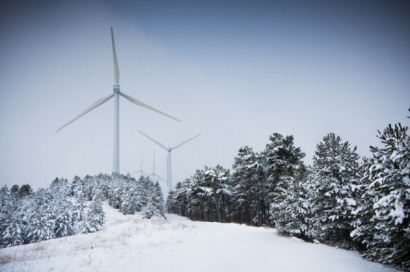
Developing wind energy in cold climates is a challenge faced daily by thousands of wind professionals worldwide. Extreme temperatures, ice accretion, densities above the standard values, etc. are all factors leading to problems that are difficult to resolve once a wind farm is built. The smart solution is therefore prevention.
In the very early stages of wind farm development, the difficulties involved in measuring cold weather climates are by no means negligible: frozen anemometers (which distorts resource assessment), measurement stations that need to be heated, or the impossibility of accessing and maintaining them during inclement weather conditions. In light of such scenarios, numerical modelling can be very helpful. This is where Vortex comes in.
An innovative solution for cold weather
"The Vortex team is from the wind sector and knows firsthand about the lack of information available to industry professionals when considering wind farm developments in cold climates," says Pep Moreno, CEO of Vortex. "That’s why we spent almost a year developing a service to estimate extreme temperatures and levels of ice accretion which makes best use of all the possibilities offered by current modelling technology to try to meet the needs of the professionals we have contact with on a daily basis through the Vortex interactive business model: web-based remote modelling on request".
The result of this development is Vortex ICING, a new product that complements the company’s existing portfolio of services: MAPS, MAST, FARM & SERIES. Like its predecessors, ICING is an extremely easy product to use as both set-up and post-processing are performed by customers themselves through the Internet using Vortex’s Google Maps-interface. In keeping with the company’s founding philosophy, manual work is left to the discretion of the user while automatic calculations are performed remotely in the massive cluster designed and managed by the company, resulting in a dramatic decrease in cost and delivery time.
10-year simulation of ice accretion
"The approach of Vortex’s work (limiting modelling to the area of interest defined by the user and parallelization of computations) allows complex phenomena such as ice accretion to be simulated over periods of 10 years within a matter of hours," says Pau Casso, Vortex’s Technical Director. "ICING has been carefully designed both at mesoscale and at microscale where significant meteorological changes in wind and humidity can be experienced."
Vortex ICING comes in two resolutions:
-3km (covering up to 25,000 km2), where the customer can determine whether conditions prevail for days per year with temperatures below a certain threshold as stipulated by legislation. -100m (currently under validation) where temperature, humidity and wind simulated at microscale are combined to estimate the growth of ice accretion.
"Apart from a few exceptions, during the measurement phase, freeze periods are usually detected by observing when anemometers freeze," adds German Delgado, Vortex’s Sales Director. "The ICING modelling enables you to estimate wind speed during those periods when no measurements are available so you can evaluate the potential loss of production on a hypothetical wind farm."
As Moreno points out, "we are obsessed with checkability at Vortex" therefore, as it has done with other products, the company invites users of its service to visit the company’s stand at the Brussels trade fair (EWEA 2011) and compare the estimates produced by ICING with their own measurements. Not surprisingly, one of the company's slogans is "Do not trust us, check us!"
Vortex comprises former wind professionals (with more than 15 years of experience), atmospheric physicists and computer experts and started its technology development in 2007. Vortex’s wind modelling technology is based on WRF, a state-of-the-art, non-linear flow code developed through a collaborative effort by several atmospheric research centres and supported by an active community of more than 10,000 users.
For additional information:

